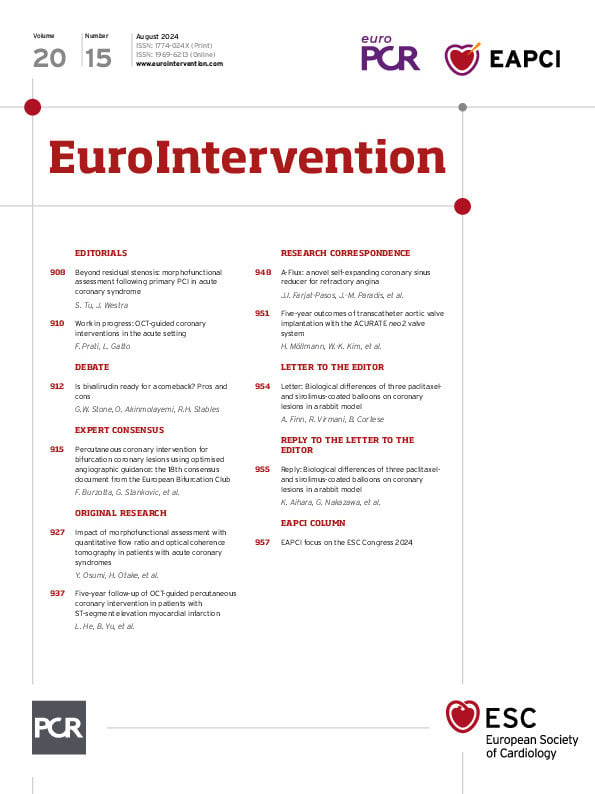Cory:
Unlock Your AI Assistant Now!
We thank Finn et al for their insights1 on our study “Biological differences of three paclitaxel- and sirolimus-coated balloons on coronary lesions in a rabbit model” and appreciate the opportunity to address their concerns.
Finn et al recommend a porcine model as preferable for evaluating drug-coated balloons (DCBs), citing its greater anatomical and physiological similarities to humans. While we recognise the advantages of using a porcine model, our choice of a rabbit model was driven by specific experimental goals aimed at “predicting clinical outcomes from preclinical data”. Our recent preclinical study demonstrated a healthy rabbit descending aorta model to compare the drug efficacy of the Ranger paclitaxel-coated balloon (PCB [Boston Scientific]) and IN.PACT PCB (Medtronic)2. This study showed similar efficacy between these 2 PCBs, which was subsequently mirrored in clinical outcomes observed in the COMPARE randomised controlled trial (RCT), demonstrating comparable primary patency between the Ranger PCB and IN.PACT PCB3. These results suggest that our rabbit model could effectively predict clinical outcomes for DCBs, meeting our goal in performing a preclinical study.
The current rabbit model demonstrated higher drug efficacy with PCBs (AGENT [Boston Scientific and SeQuent Please NEO [B. Braun]) compared to the sirolimus-coated balloon (SCB; MagicTouch [Concept Medical])4. The results in our preclinical study were echoed by a recently published RCT5, where the MagicTouch SCB failed to demonstrate non-inferiority to the SeQuent Please NEO PCB in terms of efficacy. This clinical correlation supports the relevance of our animal study findings.
Finn et al also present valuable concerns regarding drug concentrations in distal skeletal muscles and the risks of embolisation. In our study, the PCBs designed for coronary arteries (3.0/15 mm, 338 μg) exhibited low drug concentrations in distal skeletal muscles. This contrasts with findings from a prior porcine study involving the Ranger PCB (5.0/80 mm, 2,601 μg), intended for peripheral arteries, which reported higher incidences of distal emboli and greater drug concentrations6. The result was easily predictable, as the paclitaxel dose of Ranger was significantly higher than that of AGENT (Ranger vs AGENT: 2,601 μg vs 338 μg). In addition, the protocol in the porcine study involved 3 overlapping treatments in the femoral arteries, substantially increasing the total paclitaxel dose compared to our study. Therefore, the main cause of the difference in the value of drug concentration between the 2 preclinical studies was the drug dose of the DCBs used, which were chosen according to vessel size and length of the swine femoral artery and the rabbit iliac artery.
On the other hand, the muscle/artery ratio of the drug was highest in the MagicTouch SCB in our manuscript, suggesting a potentially higher risk of distal emboli compared with the PCBs. Although there have been no reported complications from distal emboli after SCB usage, the number of SCBs used in real-world clinical practice is considerably lower than that of PCBs. Moreover, a recent RCT observed a higher incidence of periprocedural myocardial infarction with the MagicTouch SCB compared to the SeQuent Please NEO PCB, though the difference was not statistically significant. Therefore, further clinical studies involving a larger patient cohort are needed to evaluate the clinical safety of SCBs.
We believe our study adds valuable data to the existing literature and highlights the need for continued research in this field. We are grateful for the engagement of Finn et al, as their comments help deepen our understanding and drive the field forward.
Conflict of interest statement
S. Torii received research grants from Abbott Vascular Japan, Boston Scientific Japan, Medtronic, Asahi Intecc, Orbus Neich and Japan Medical Device Technology Co., Ltd; and received honoraria from Boston Scientific Japan. G. Nakazawa is a consultant for Boston Scientific, Abbott Vascular, Terumo Corp., Asahi Intecc and Japan Medical Device Technology Co., Ltd; and received research grants from Boston Scientific, Abbott Vascular, Terumo Corp., Japan Medical Device Technology Co., Ltd. The remaining authors have no conflicts of interest to disclose.

